Why you should be fermenting your homegrown cabbage
Simple ferments can do wonders for your gut. Even better, the very best vegetables to use are the ones you grow yourself.
Words: Nadene Hall Main images: Sally Tagg Additional images: Kelli Walker, Nadene Hall
Who: Kelli Walker
What: Fer-mentor
Where: Clevedon, 35 minutes south-east of Auckland
Web: www.forageandferment.co.nz
It can be little daunting when Kelli Walker offers you a shot glass of orange-coloured liquid and dares you to drink it, her eyes twinkling. It isn’t alcoholic but trying to describe the flavour defies words.
Perhaps umami, definitely a complete overwhelm for the taste buds. A second or two after swallowing, it creates an entirely new flavour in your mouth with a little goodbye kick.
The liquid is left over after Kelli and the Forage & Ferment team have finished making their popular carrot, ginger, turmeric and marigold sauerkraut. It’s full of good bacteria, yeast, and probiotics. Kelli is now bottling it to sell as a wild tonic shot challenge, but also for people to add to salad dressings and marinades.
READ MORE: Easy sauerkraut for beginners: Kelli Walker’s tips for the perfect ferment
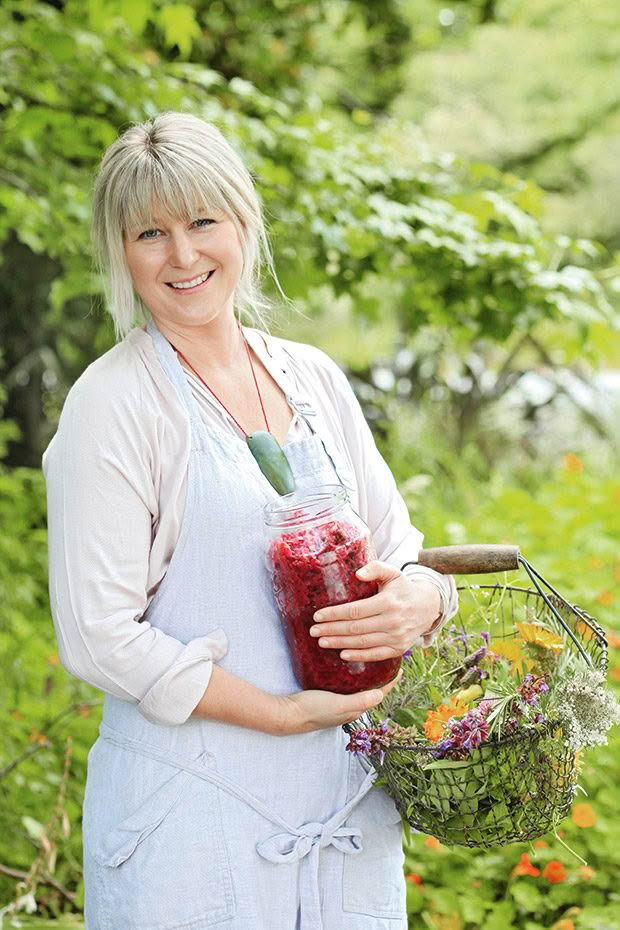
To cleanse the palate, she offers a tall glass of her home-made water kefir, flavoured with beetroot and ginger. It’s faintly sweet but mostly tangy, sparkling with bubbles.
“The flavours get me,” says Kelli. “They’re the complex, tangy, zingy, zany, funky flavours of ferments.”
Kelli has been hooked on fermenting since she made her first sauerkraut, inspired by the amazing gut-health benefits, the simplicity of the process, and the tangy flavours. She now sells her own ferments, producing a range of sauerkraut, kimchi, and drinks to gourmet food stores around NZ, and at her local farmer’s market.
One of her favourite things about ferments is that the result is very much your own, even if you follow her recipe to the letter.
“It’s not about ‘I couldn’t make mine taste like yours’. It’s not about right or wrong, it’s about creating your own ferment. In Korea, there’s no set recipe for kimchi because every family has their own way of making it, and it tastes different. Everyone does it a little bit differently.
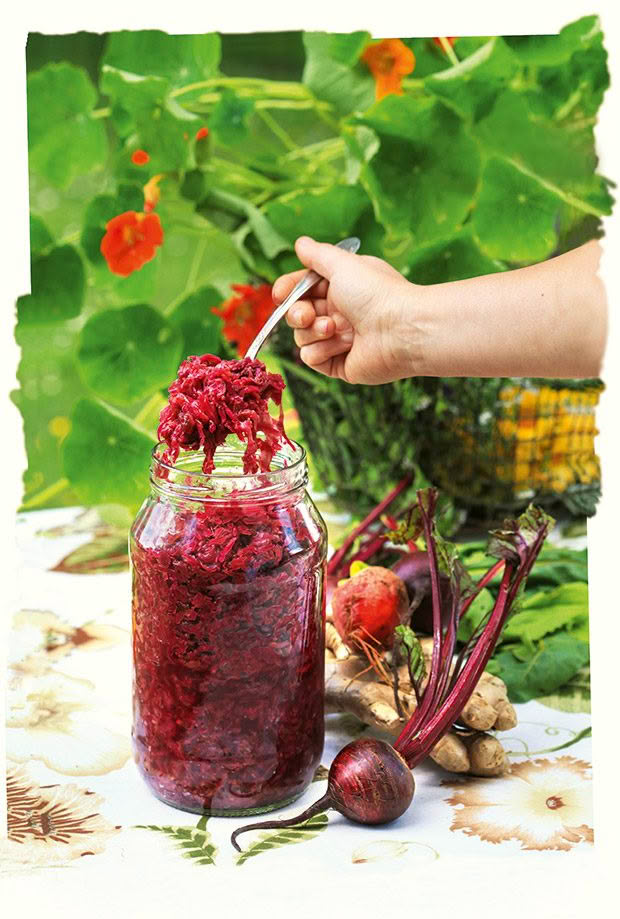
“I love the alchemy of it, the witchy-ness of it. I can experiment, be creative, be playful and fun, and test myself.”
But it’s not just tweaking the recipe that makes a ferment from your kitchen taste different from one made by Kelli. Lactic acid bacteria from the environment become part of the fermentation process. It lives on the skin of the vegetables you use, and your skin too.
“Your one will always taste different from mine: you’ve got different vegetables, you’re in a different environment, and you have lactic acid bacteria on you and your vegetables, and that’s all local terroir. Every time you make a ferment, your lactic acid bacteria are going into it. You’re creating something unique to you and your family, your region.”
This ancient method of preserving food is something Kelli is passionate about.
“It might sound a bit romantic, but you’re reclaiming some basic knowledge and life skills. This is one of the oldest ways and the most nourishing ways to preserve food, and there’s power and magic in it. And it’s easy to do!”
WHY CABBAGE IS KING
Cabbage is the star of two of the most popular vegetable ferments, sauerkraut (‘sour cabbage’) and kimchi, a spicy pickled cabbage from Korea. That’s thanks to the cabbage’s carbohydrates, sugars, and its structure, which means it doesn’t go mushy and limp as it ferments. Cabbage is also quite mild and can be easily flavoured.
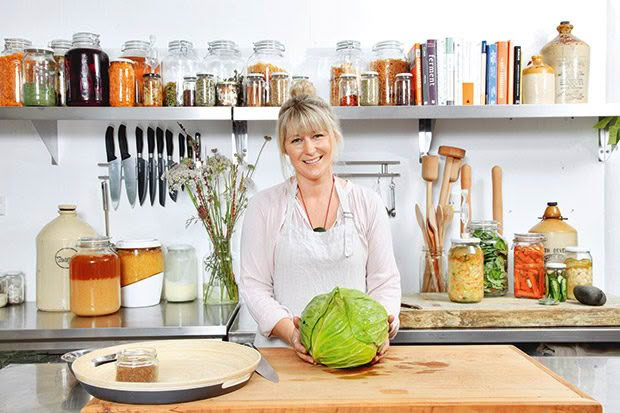
Cabbage varieties, green or red (purple), can be used interchangeably in recipes. Kelli loves red ones for their pretty colour, and their high nutrient levels. Red cabbage have high vitamin C levels, and are rich in anti-oxidant anthocyanins, which give them their vivid colour.
Age can make a difference to the flavour, says Kelli.
“In my experience, younger cabbages produce a sweeter ferment as there are more sugars in it. You can also use an older cabbage, a big boy that’s been in your garden for a long time, but I wouldn’t ferment with a cabbage that’s been sitting in your fridge for three weeks.”
TIP: THIS HERITAGE CABBAGE IS THE TASTIEST
There was one clear favourite in a taste test of sauerkrauts, all made the same way but using different varieties of cabbage.
Copenhagen Market is a heritage variety of cabbage, weighing 2-2.5kg when mature. It’s early maturing, prefers cooler summers, and lots of water.
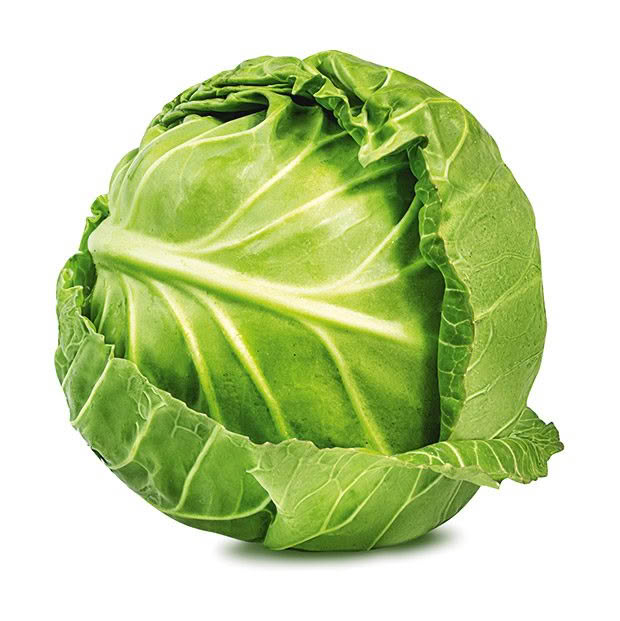
It also stores well, thanks to tightly-wrapped leaves. Seeds are available from Kings Seeds.
Source: Investigating the Effect of Cabbage Variety on the Characteristics of Sauerkraut Produced Using Local Cabbage Varieties, 2012.
WHY HOMEGROWN IS BEST
Like wine and cheese, the flavour of fermented vegetables is influenced by the local terroir (pron. ‘tear-wah’). Terroir is all the elements of a crop’s environment as it grows, including the soil, water, climate, and air. The more unique the terroir, the more influence it will have on a crop’s flavour.
Vegetables also have lactic acid bacteria on their skin and you want that in your ferment. The fresher a vegetable is, the more naturally it is grown, the more you’re going to get out of it, says Kelli.

“Before you wash anything, remember what you’re really doing is removing all the lactic acid bacteria on your beautiful vegetables. If they’re dirty, wash (the dirt) off, but you don’t need to scrub them or spray them because you don’t want to remove those beautiful bacteria. That’s why growing your own vegetables for your ferments or buying them from a farmer’s market is so wonderful.”
JARS OF GOODNESS
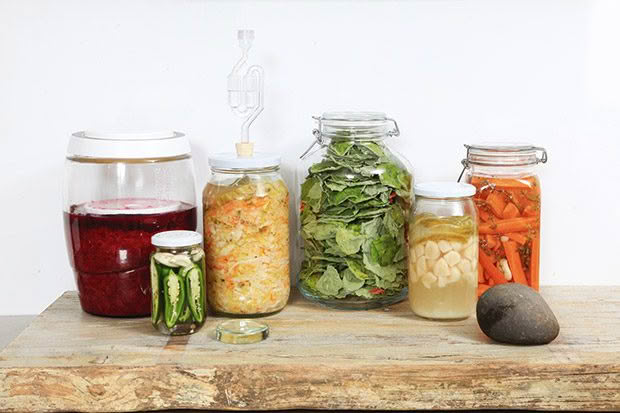
The beauty of ferments is you don’t need to buy any fancy equipment to get started. However, there are a few things that can make fermentation easier.
1. Glass fermenting crock
This 5-litre crock comes with a plastic follower which sits on top of the ingredients, to hold the solids under the brine. The lid screws onto the jar. It has an opening on top, with another lid that sits in a ‘moat’ which is filled with water. This means oxygen can’t get in, but gases released by a ferment can bubble out.
2. Jar with airlock
This is a recycled 2-litre glass jar with a screwtop lid. Kelli has put a hole in the lid, then inserted a small plastic airlock which you can buy from home brew stores (in-store or online) or on Trade Me. These are filled with water and allow gases to escape, but no oxygen to enter.
3. Fermented garlic
This is peeled, raw garlic in a 2% brine of water and salt, with a cabbage leaf to hold the cloves under the level of the brine. They taste great after a week, and the garlic-flavoured brine is a delicious addition to dressings and marinades.
4. Followers
You may see a river stone and a glass weight on the bench, but Kelli uses both as weights to hold a follower (and what’s under it) beneath the brine.
A follower is any object that holds the ingredients under the level of the brine, keeping them submerged in the anaerobic environment required for fermentation. In a crock, it’s a plastic disc; mostly, Kelli uses large, outer cabbage leaves, tucking them down the sides.
She then places a weight on top. One of her options is a smooth, hard river stone she cleans by boiling for at least 10 minutes. Other options include a carrot or a cabbage stalk, cut to sit level with the top of the jar.
5. Recycled jars
A fermenting jar can be any size. It won’t affect how fast or slow the ferment occurs. Ensure the jar has a lid that seals well.
6. Pickled carrots (a child-friendly ferment)
Ferment carrots in a 4% salt-water brine for a week and you get a delicious, sweet, tangy snack that any child will love.
“You can flavour the carrots with some ginger or garlic or chilli,” says Kelli. “I’ve had carrots in my fridge for over a year and I love them. I probably couldn’t get (my sons) to eat those ones, but I certainly eat them with some hummus. It’s a zany, funky, divine taste.”
You can do the same thing with green beans (ferment for four days), and cauliflower with curry (ferment for several weeks).
MORE HERE:
Recipe: Forage & Ferment’s Wild Sauerkraut with Turmeric, Ginger and Marigold
The buzz on Kelli Walker’s burgeoning business, Forage & Ferment
Love this story? Subscribe now!
 This article first appeared in NZ Lifestyle Block Magazine.
This article first appeared in NZ Lifestyle Block Magazine.
